In fact, on the real Mars missions, some of those project must be collaborate with earthling supporters. Because we, marsnauts never living alone. So today’s commander report and photo report become an example of a collaborated work with a specialist from Earth. The following article based on commander’s recollections, written by Taro Karasaki, Japanese writer of Asahi Weekly. And Crew191 did an outreach EVA today, to shoot some photos correspond related to the article.
Enjoy “A Day on Mars” adventure !
Crew191 Commander,
Yusuke Murakami
* * *
“A Day on Mars”
By Taro Karasaki, Japanese Writer of Asahi Weekly
Based on Recollections of MDRS Crew191 Commander Yusuke Murakami
(English)
“Wow – will you look at that!”
It was my colleague Emi again, pressing her smartphone against the windshield of our Mars exploration vehicle. “Stop the rover, please? I need to shoot this!”
Before our eyes was Olympus Mons, the tallest peak on Mars — in fact, the tallest known volcano in the solar system — its ridge glowing in the sunlight.
“Not again,” I said rolling my eyes as I watched the latest addition to our Mars exploration team, flailing her arms.
Emi is a personality-turned-essayist assigned to do a column for Asahi Weekly about life on this red planet and how English is being used by the crew as the lingua franca for space missions.
Since Emi arrived a few weeks ago, I found myself frustrated every time she whipped out her smartphone. Just when I thought she started to calm down after being warned of the harsh environment around us at base camp, one step outside she was back to her old self.
I tried to calm myself by reminding myself how I reacted when I saw my first crater two years ago. Pretty much the same – After 270 days confined aboard a crammed spaceship, you want to stretch out.
I was also all too aware that our company went out of its way to enlist Emi, whose spunky and outgoing character could help boost interest towards the Mars development project, and hopefully, our publication.
But we had an agenda – aside from taking photos and doing a video report today, we had to assist our geologist in collecting samples and keep alert for any signs of danger – and only an hour’s time during our EVA (extravehicular activity) to do it all before jumping back in the pressurized rover and returning to base.
We couldn’t put our mission, or our lives, at jeopardy so that one reporter could update her Instagram account. Calmly, I asked Emi the million-dollar question.
“How many flags did you see?”
“What flags?”
Just as I thought.
Completely excited about her first long distance roving mission, Emi had forgotten what I asked her before we left base camp. She hadn’t noticed the flag markers that were meticulously set up every 500 meters to mark the safest and fastest course to Mount Olympus. The first mission spent weeks braving sandstorms to set up the markers. Pretty soon she herself would be in charge of marking a new route.
“Make sure you count the flags on the way back,” I said firmly, without letting my irritation show. “Let’s go over our checklist once more.”
I have spent the last two years as a journalist documenting the construction of our base, the first step to creating a colony for possible emigration. So what is an ordinary guy like me – who failed math in high school and is not particularly athletic type – doing up here, you may ask.
I am one of a group of “generalists” who hail from various backgrounds and include teachers, sports trainers and carpenters. We work alongside the specialists – scientists and pilots – in the Mars mission.
“There is room for everyone up here,” as my mentor, Yusuke, a veteran Mars mission member, told me before I left Earth. Eventually, more people like us will be needed to create a sustainable environment in space.
As for myself, along with assisting the specialists (whom I observed and collected notes on during our long flight) I try to use my reporter’s eye to look out for slight changes in human behavior, which could help prevent unwanted tensions in our closed environment. Sometimes a little small talk can do wonders to soothe nerves.
In addition, I also studied horticulture before embarking on this mission, and I it’s my duty to take care of the vegetable patch at base camp.
Our rover rumbled to a stop. I watched as Emi eagerly got into her spacesuit before the seat belt signs were turned off. As I saw her nimbly walk to the hatch, I knew I needed to interrupt.
“Aren’t we forgetting something? Don’t make me write your obituary.” I tried to get the message across without sounding too harsh: Anything can go wrong. A sandstorm could suddenly wallop us. A system malfunction could interrupt our fieldwork. We needed to stick to the rules as there is little leeway for error.
“Rodger that,” she grumbled, before going through the routine check to see if the oxygen supply was working and all communication systems functioned.
* * *
“Wow,” was all I could say. Rising over 20 kilometers in the sky, or more than twice the height of Mount Everest, Olympus Mons was formidable. What looked from our spaceship like a blister rising up from the otherwise smooth terrain was now a massive wall standing imposingly before us.
We cautiously approached what appeared to be a ledge. Surrounding Olympus is a deep trench, measuring about two kilometers deep in some places. Keeping one eye on my colleague as she busily snapped away at the chasm and the giant formation rising before us, as well as our geologist, I quickly retrieved vials containing soil samples that might give us a better idea about what Mars was like when water is said to have existed in abundance on its now dry surface. After labeling them, I placed them in order in the carrying case.
“Taro-san, your space pen,” I turned around to see Emi standing beside me. “It looks like you’re running out of ink.” I looked down at the vials. She was right. I could still read what I had written, but the lines were getting thinner. Emi offered her brand-new pen.
Before we know it, our time is up, and we climb aboard the rover. The drive back to base camp is long and our mission is not yet over. We still have to drop off extra fuel cells at depots along the way so that the next team won’t have to worry about running out of power when they come out here. And there is some unfinished business for Emi.
“Remember to keep an eye out for those flags,” I tell Emi, and she nods, her pen and notebook in hand.
* * *
Emi smiled as she heard my stomach growl. We had now entered the base camp and removed our gear. It had been a long day, and I’d forgotten all about eating.
I am told that a sukiyaki party will be held – a ritual to greet our new team members and send off those who will soon finish their tour of duty.
While it will be mostly freeze-dried beef, tofu and konnyaku (devil’s tongue), at least the shungiku (garland chrysanthemum) and green onions will be local produce. Already I’m worrying again if the crew that stayed behind heeded my words and harvested the right batch and left the young leaves to grow some more.
There is so much I have to pass on to Emi and so little time. And there are things she must learn by herself.
For now, at least, it’s probably time to sit down and enjoy a well-deserved meal.
(Japanese)
『ある火星の一日』
柄崎太郎著、原作・村上祐資
「すごい。あれをを見て!」
また同僚のエミが、火星探査用の四輪駆動車のフロントガラスにスマホを押しつけながら、叫んでいだ。
「ローバーを止めて。ね、お願い?写真を撮らなきゃ!」
目の前には、火星で、いや、太陽系で確認された最も標高の高い火山、オリンパス山がそびえ立っていた。太陽の光に照らされ、その稜線が輝いていた。
「またか」私は呆れたように、わが火星探査チームの最も新しいメンバーの興奮する様子を見ていた。
ところで、エミとは私が働く朝日ウイークリーが雇ったタレントからエッセイストに転身した女性で、火星での有人探査の様子と、隊員の間で公用語として使われる英語の実態について取材しに来たのだ。
数週間前に到着したばかりのエミが、ことあるごとにスマホを取り出すことに私はイライラしていた。基地でこの環境の苛酷さについてレクを受け、ようやく落ち着いたと思ったら、外に出た途端、元に戻った。
私は2年前、火星に到着しばかりで、初めてのクレーターを見た時の自分の様子を思い出しながら、気持ちを落ち着かせた。270日間も宇宙船に閉じ込められて、誰だって少しくらい羽根を伸ばしたくなる。
そして、同時に、エミはその元気で人懐っこい性格を活かして、火星の開発プログラムに対する理解を深めるために(そして私たちの媒体に関心を持ってもらうために)雇われていることも、理解していた。
しかし、私たちには任務があった。写真を撮ったり、ビデオを撮ったりする以外に、同行させてもらっている地質学者の標本採集の手伝いや、安全確認など、やることがいっぱいだった。そして、船外活動のタイムリミットは1時間。そのあと、予定通りに与圧されたローバーに乗り込んで、基地に向けて出発しなければいけない。
たった一人の人間がインスタグラムを更新するためにミッションはもちろん、隊員の命を危険にさらすことはできない。私はそこで、エミにズバリ聞くことにした。
「旗は何本立っていた?」
「なんの旗?」
思った通りだ。初めての長距離ロービング活動で興奮していたエミは基地で頼んだことを忘れていた。それは1次探査チームのときから、砂嵐などに悩まされながら、障害物を避けながらなるべく早くオリンパス山にいけるコースを見失わないために500メートルの間隔で立てた旗だ。数週間後には彼女も同じように旗を立てる作業に従事するのだ。
「わかった。帰りはちゃんと数えるように」。なるべく、いら立ちを感づかれないように、冷静に話した。
「チェックリストをもう一度確認しよう」
この2年間、火星移住計画のための第一歩ともいえる基地の建設を記録してきたわけだが、高校時代数学で赤点をとり、運動神経もさほどよくない私がなぜこんなミッションに参加できたのか、皆さまは疑問だろう。
私は、最近、火星プロジェクトに加わり始めた「ジェネラリスト」と呼ばれるタイプの隊員の一人だ。ジャーナリスト以外に教師やスポーツトレーナー、大工など幅広いバックグラウンドを持った人材が集まっている。私たちはスペシャリストである科学者やパイロット出身の隊員とともに、仕事をしている。
私の先輩であるユウスケさんの言葉を借りれば、「宇宙はさまざまなタイプの人が必要だ」というわけだ。やがて、私たちのような人が増えることは、地球と同じような持続可能な環境をつくるために不可欠なことだ。
私の場合、記者として、養った観察眼を活かし、人の微妙な態度の変化などをチェックすることで、この非常にせまい生活空間の中で些細な衝突を防ぐことを一つの大切な任務としている。例えば、ある隊員の応援している野球チームの話題で、少しでも気晴らしをしてもらえるなら、私の能力も活かされる。
また、出発前に園芸の勉強をした私は、基地内にある菜園を任されている。
ローバーはゆっくりと止まった。シートベルト着用のサインが消える前から、宇宙服をいそいそと着込むエミのすがたを私は見ながら、不安を覚えた。彼女がハッチに向かっていそいそと歩いていくのを見て、止めに入った。
「なんか忘れていないか。お前の訃報記事を書くつもりはないぞ」私は、あまりきつく響かない程度に諭すつもりで言った。宇宙では予想もしないことが起きる。突然の砂嵐が襲い掛かるかもしれないし、システムの不具合で探査が進まないこともある。ここではまずルール通りにやることが大事。失敗の余地がないから。
「了解です」。すこし、面白くなさそうにエミは答えながら、酸素の供給と通信システムのチェックに応じた。
***
「こりゃ、すごいや」。目の前にそびえ立つ標高20キロ、エベレストの2倍の高さのオリンポス山を見ながらそう思った。宇宙船からはすべすべした肌にできた腫物のようなそのオリンポス山はまるで目の前を遮る巨大な壁のようだった。
恐る恐る、先にある崖のようなところに近づいた。オリンポス山の周りは約2キロの深さの溝がある。写真を撮り続ける同僚と探査活動をする地質学者から目を離さないようにしながら、拾い集めたサンプルが入った容器を回収し、それを順番にケースに収めた。このあたりの土壌は火星が水で覆われていた時代の様子を伝えてくれると思われる。
「タロウさん、ペンのインクが切れそうだよ」。エミの言葉にはっとして、手元を見たら、筆跡が強いため、なんとか読めるものの、ラベルの文字がかすれ始めていた。エミは支給されたばかりの自分のペンを貸してくれた。
そうこうしているとすぐ時間は経ってしまった。私たちはローバーに再び乗り、基地に戻ることになった。基地までの道のりは長く、まだいろいろと任務が残っている。途中で絵燃料セルをデポに置いていく。のちにここを訪れるであろう隊員が燃料切れにならないためだ。そして、エミにもう一つ仕事があった。
「旗をちゃんと見ろよ」私はエミにそういうと、彼女はペンとメモを手にうなずいた。
***
基地に到着し、荷物を下ろしたあと、私のお腹が鳴るのを聞いたエミが笑った。
忙しかったあまり、腹をすかしていたことすら気づいていなかった。
今日は新しい隊員の歓迎会と、もうすぐ任務を終える隊員の壮行会を兼ねたすき焼きパーティーが開かれると聞いた。材料の牛肉や豆腐、こんにゃくはフリーズドライだが、春菊やネギはここで作ったものだ。また、留守番をした隊員がちゃんと、私が頼んだように若い葉を残し、正しい苗だけを収穫したかどうか心配になった。
エミにはまだまだ伝えなければいけないことがある。そして、残された時間はあまりない。同時に彼女が自分で学ばなければいけないこともある。
とりあえず今は、待ちに待った食事を楽しむことにしょう。
* * *
Afterword
By Taro Karasaki
We are proud to announce that an article titled “A Day on Mars” collaborated with MDRS Crew191 Commander Yusuke Murakami, will be published in the April 1 issue of Asahi Weekly in Japan.
This week, our travelogue writer takes us to Planet Mars. The third planet in the solar system is known for its diverse terrain, and its tallest peak Olympus Mon rises above 20,000 meters.
As you may be aware by now, April 1st is April Fools’ Day. In many countries, newspapers prominently run articles with such outlandish headlines as “Martians Visit Earth.” The Asahi Weekly took the liberty to run its own “April Fools’ Day story.” Since the 1960s many countries have sent Mars probes in hopes of observing the red planet. However, no human has actually stepped foot on Mars.
On the other hand, there are people who have experienced living for prolonged periods of time in environments similar to that on Mars. In a bid to create a realistic feel, we sought the advice of architect Yusuke Murakami, an expert in architecture in extreme environments. Murakami participated in simulated long term missions at Arctic and desert facilities organized by the U.S.-based “The Mars Society.” The article is based upon recollections of his experience in these remote and harsh environments.
A point made repeatedly by Murakami during our interview and worth mentioning: As mentioned in the travelogue, in the future, those who will be involved in the exploration of Mars will include people hailing from a wide background of careers and walks of life; not just “specialists” as pilots and scientists. When you come to think of it, travel to Mars — and a travelogue — may no longer seem like an “outlandish” story after all.


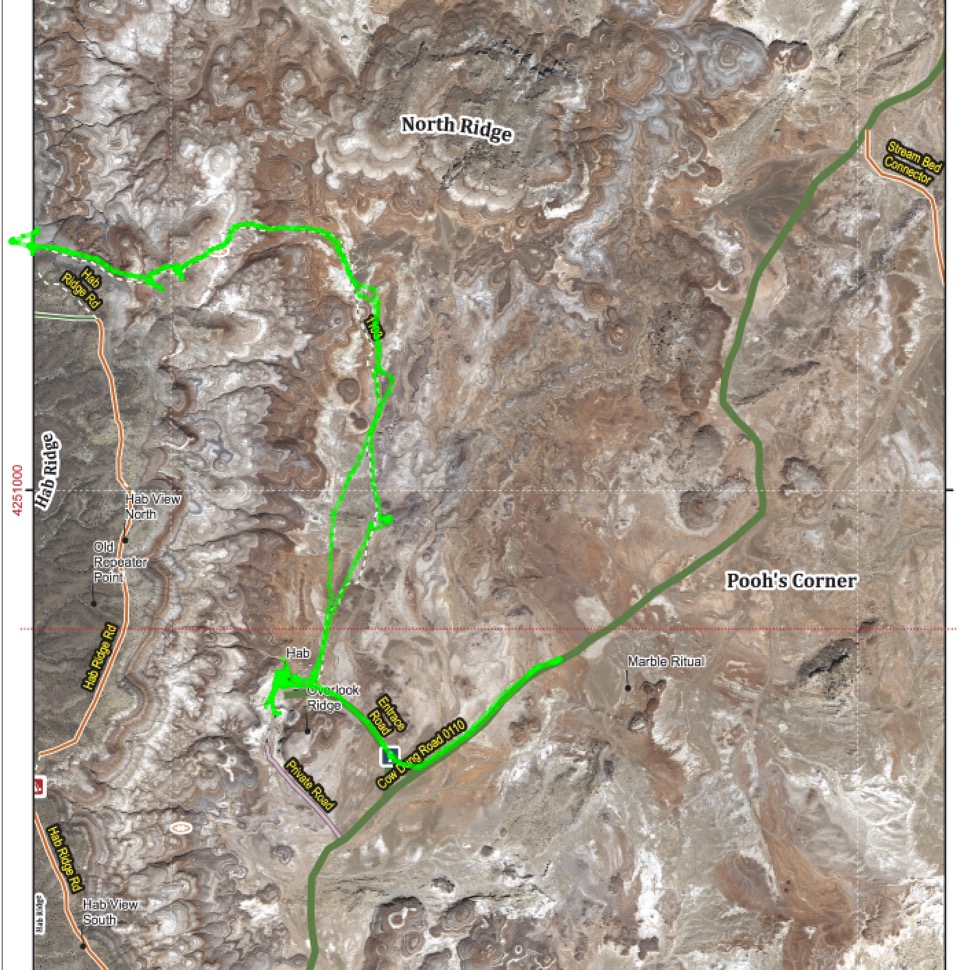
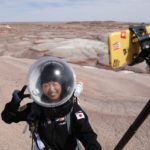
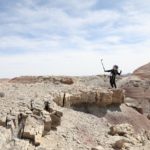

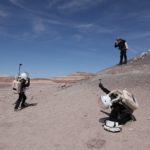
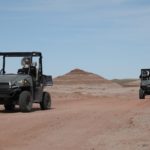

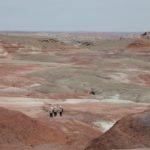

You must be logged in to post a comment.